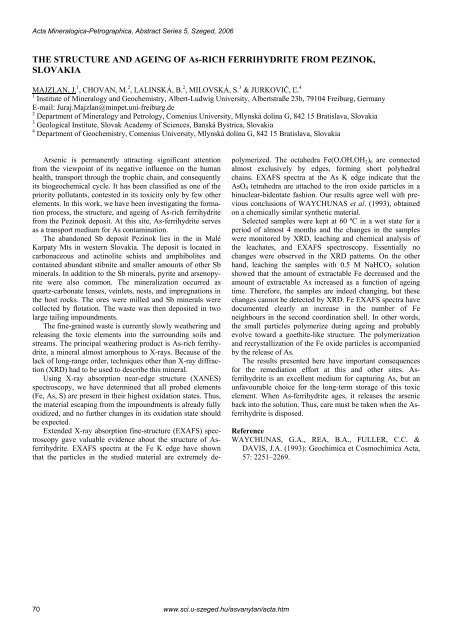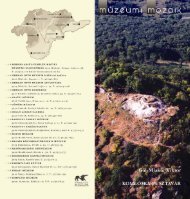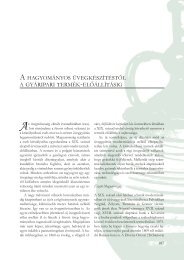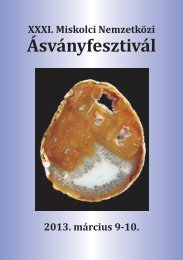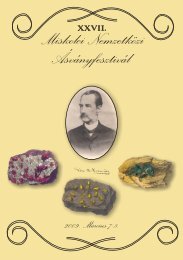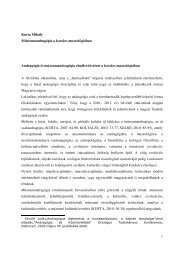Acta Mineralogica-Petrographica, Abstract Series 5, Szeged, 2006<strong>THE</strong> STRUCTURE AND AGE<strong>IN</strong>G OF As-RICH FERRIHYDRITE FROM PEZ<strong>IN</strong>OK,SLOVAKIAMAJZLAN, J. 1 , CHOVAN, M. 2 , LAL<strong>IN</strong>SKÁ, B. 2 , MILOVSKÁ, S. 3 & JURKOVIČ, Ľ. 41 Institute of Mineralogy and Geochemistry, Albert-Ludwig University, Albertstraße 23b, 79104 Freiburg, GermanyE-mail: Juraj.Majzlan@minpet.uni-freiburg.de2 Department of Mineralogy and Petrology, Comenius University, Mlynská dolina G, 842 15 Bratislava, Slovakia3 Geological Institute, Slovak Academy of Sciences, Banská Bystrica, Slovakia4 Department of Geochemistry, Comenius University, Mlynská dolina G, 842 15 Bratislava, SlovakiaArsenic is permanently attracting significant attentionfrom the viewpoint of its negative influence on the humanhealth, transport through the trophic chain, and consequentlyits biogeochemical cycle. It has been classified as one of thepriority pollutants, contested in its toxicity only by few otherelements. In this work, we have been investigating the formationprocess, the structure, and ageing of As-rich ferrihydritefrom the Pezinok deposit. At this site, As-ferrihydrite servesas a transport medium for As contamination.The abandoned Sb deposit Pezinok lies in the in MaléKarpaty Mts in western Slovakia. The deposit is located incarbonaceous and actinolite schists and amphibolites andcontained abundant stibnite and smaller amounts of other Sbminerals. In addition to the Sb minerals, pyrite and arsenopyritewere also common. The mineralization occurred asquartz-carbonate lenses, veinlets, nests, and impregnations inthe host rocks. The ores were milled and Sb minerals werecollected by flotation. The waste was then deposited in twolarge tailing impoundments.The fine-grained waste is currently slowly weathering andreleasing the toxic elements into the surrounding soils andstreams. The principal weathering product is As-rich ferrihydrite,a mineral almost amorphous to X-rays. Because of thelack of long-range order, techniques other than X-ray diffraction(XRD) had to be used to describe this mineral.Using X-ray absorption near-edge structure (XANES)spectroscopy, we have determined that all probed elements(Fe, As, S) are present in their highest oxidation states. Thus,the material escaping from the impoundments is already fullyoxidized, and no further changes in its oxidation state shouldbe expected.Extended X-ray absorption fine-structure (EXAFS) spectroscopygave valuable evidence about the structure of Asferrihydrite.EXAFS spectra at the Fe K edge have shownthat the particles in the studied material are extremely depolymerized.The octahedra Fe(O,OH,OH 2 ) 6 are connectedalmost exclusively by edges, forming short polyhedralchains. EXAFS spectra at the As K edge indicate that theAsO 4 tetrahedra are attached to the iron oxide particles in abinuclear-bidentate fashion. Our results agree well with previousconclusions of WAYCHUNAS et al. (1993), obtainedon a chemically similar synthetic material.Selected samples were kept at 60 ºC in a wet state for aperiod of almost 4 months and the changes in the sampleswere monitored by XRD, leaching and chemical analysis ofthe leachates, and EXAFS spectroscopy. Essentially nochanges were observed in the XRD patterns. On the otherhand, leaching the samples with 0.5 M NaHCO 3 solutionshowed that the amount of extractable Fe decreased and theamount of extractable As increased as a function of ageingtime. Therefore, the samples are indeed changing, but thesechanges cannot be detected by XRD. Fe EXAFS spectra havedocumented clearly an increase in the number of Feneighbours in the second coordination shell. In other words,the small particles polymerize during ageing and probablyevolve toward a goethite-like structure. The polymerizationand recrystallization of the Fe oxide particles is accompaniedby the release of As.The results presented here have important consequencesfor the remediation effort at this and other sites. Asferrihydriteis an excellent medium for capturing As, but anunfavourable choice for the long-term storage of this toxicelement. When As-ferrihydrite ages, it releases the arsenicback into the solution. Thus, care must be taken when the Asferrihydriteis disposed.ReferenceWAYCHUNAS, G.A., REA, B.A., FULLER, C.C. &DAVIS, J.A. (1993): Geochimica et Cosmochimica Acta,57: 2251–2269.70www.sci.u-szeged.hu/asvanytan/acta.htm
Acta Mineralogica-Petrographica, Abstract Series 5, Szeged, 2006<strong>M<strong>IN</strong>ERAL</strong>OGICAL DATA ON <strong>THE</strong> BAT GUANO DEPOSIT FROM POLOVRAGI CAVE(CĂPĂŢÂNII MOUNTA<strong>IN</strong>S, ROMANIA)MAR<strong>IN</strong>CEA, Ş. 1 , DUMITRAŞ, D.-G. 1 , DIACONU, G. 2 & BILAL, E. 31 Geological Institute of Romania, Bucharest, RomaniaE-mail: marincea@igr.ro2 “Emil Racoviţă” Institute of Speleology, Bucharest, Romania3 École Nationale Supérieure des Mines, Saint Etienne, FranceRecent investigations in one of the most famous cavesfrom the South Carpathians (Romania), namely the PolovragiCave in Căpăţânii Mountains, prompted to the identificationof a quite representative fossil bat guano deposit, whose mineralogywas so far ignored. The cave is located on the leftslope of Olteţ Valley, at about 2 km upstream from thePolovragi Monastery and 200 m upstream from the end of theOlteţ Gorges. The cave, which is one of the longest in Romania(having more than 9 km in length), is developed in massivelimestones of Upper Jurassic – Neocomian age. The caveis typically dry, the mean temperature being of about 8°C,with small variations over the seasons. This favors the presenceof an active bat colony, located mainly in the initialportion of the cave and particularly in the so-called “BatGallery”. Patches of slightly indurate guano cover the floor ofthis gallery. The present study aims to give some preliminarymineralogical data on the main mineral species in the deposit,issued from their examination by scanning electron microscopy(SEM), inductively-coupled plasma - atomic emissionspectrometry (ICP-AES) and X-ray powder diffraction(XRD).Restricted to the guano patches, the mineral associationincludes hydroxylapatite, brushite, taranakite, low quartz,illite (the 2M 1 polytype), amorphous iron sesquioxides andcalcite. The unit-cell parameters of selected specimens ofthese mineral species, refined by least-squares from X-raypowder data (Cu K α , λ = 1.54056 Å) are given in the followingTable:Mineral System, S.G. Sample a (Å) b (Å) c (Å) β ( ° ) n Nhydroxylapatite H, P6 3 /m PP 3 B 9.426(3) - 6.879(3) - 4 38hydroxylapatite H, P6 3 /m PP 4 A 9.405(3) - 6.867(3) - 10 41brushite M, Ia PP 1 A 5.797(2) 15.163(7) 6.228(3) 116.28(2) 7 70taranakite R, R 3 c PP 1 A 8.690(3) - 94.90(5) - 3 88quartz R, P3 1 21 PP 2 B 4.909(1) - 5.398(2) - 4 20illite 2M1 M, C2/c PP 1 B 5.215(8) 8.974(6) 19.98(2) 94.27(9) 6 20calcite R, R 3 c PP 4 A 4.9843(9) - 17.037(6) - 4 26S.G.: space group; n: number of refining cycles; N: number of reflections used for refinement in the 2θ range 16–88° for hydroxylapatite,5–90° for brushite, 5–66° for taranakite and 10–90° for quartz and calcite.Hydroxylapatite occurs in the lower part of the guanopile, at the direct contact with the carbonate floor. The mineralforms white-yellow or orange crusts composed by fineplaty crystals of up to 20-µm diameter and 1 µm in thickness,randomly disposed or forming post-colloidal, rosette-likeaggregates. The mineral has typically a reduced crystallinity:the indices of crystallinity, calculated using the method proposedby SIMPSON (1964) are, for the two samples in theTable, 0.211 and 0.167, respectively. A ICP-AES analysis ofa carefully handpicked separate, recalculated at 100 % afterdeduction of water in order to assess the charge balance, gave(in wt%): K 2 O = 0.04, Na 2 O = 0.02, CaO = 54.96, MnO =0.08, MgO = 0.05, FeO = 0.41, P 2 O 5 = 42.28, SO 3 = 0.23,H 2 O = 1.93. This composition, normalized on the basis of6 (P + S) and 26 (O,OH) per formula unit (pfu), leads to thechemical-structural formula: [K 0.009 Na 0.006 Ca 9.824 Mn 0.011Mg 0.012 Fe 2+ 0.057](P 5.971 S 0.029 )O 23.852 (OH) 2.148 .Brushite forms millimeter-sized snow white coatings onhydroxylapatite or small (up to 5 mm in diameter) nodules inthe guano mass. The SEM study showed that the brushiteaggregates are composed of finely bladed crystals, flattenedon (010) and elongated toward a direction that may be [101]or [102]. Individual crystals are up to 0.1 µm thick, 7 µmwide and 15 µm long. The ICP-AES analysis of the samplePP 1 A yielded (in wt%): Na 2 O = 0.01, CaO = 32.48, MnO =0.03, MgO = 0.02, FeO = 0.03, P 2 O 5 = 40.08, SO 3 = 1.32,H 2 O (as calculated for the charge balance) = 26.03. Thiscomposition, normalized on the basis of 1 (P+S) and 4 (O) inthe anhydrous part of the compound, leads to the chemicalstructuralformula:[Na 0.001 Ca 0.996 Mn 0.001 Mg 0.001 Fe 2+ 0.001](HPO 4 ) 0.972 (SO 4 ) 0.028 •2H 2 O.Taranakite occurs as dull white crusts or small veins ofchalky appearance composed by clusters of crystals whoseSEM examination shows roughly hexagonal forms. The individualcrystals are up to 15 µm across and 1 µm thick. Themineral is typically associated with 2M 1 illite and low (alpha)quartz. The cell parameters in the Table are indicative for avariety with low ammonium content.ReferenceSIMPSON, D.R. (1964): American Mineralogist, 49: 363–376.www.sci.u-szeged.hu/asvanytan/acta.htm 71
- Page 1:
MSCC33 rd MINERAL SCIENCES IN THE C
- Page 5 and 6:
Acta Mineralogica-Petrographica, Ab
- Page 7 and 8:
Acta Mineralogica-Petrographica, Ab
- Page 9 and 10:
Acta Mineralogica-Petrographica, Ab
- Page 11 and 12:
Acta Mineralogica-Petrographica, Ab
- Page 13 and 14:
Acta Mineralogica-Petrographica, Ab
- Page 15 and 16:
Acta Mineralogica-Petrographica, Ab
- Page 17 and 18:
Acta Mineralogica-Petrographica, Ab
- Page 19 and 20: Acta Mineralogica-Petrographica, Ab
- Page 21 and 22: Acta Mineralogica-Petrographica, Ab
- Page 23 and 24: Acta Mineralogica-Petrographica, Ab
- Page 25 and 26: Acta Mineralogica-Petrographica, Ab
- Page 27 and 28: Acta Mineralogica-Petrographica, Ab
- Page 29 and 30: Acta Mineralogica-Petrographica, Ab
- Page 31 and 32: Acta Mineralogica-Petrographica, Ab
- Page 33 and 34: Acta Mineralogica-Petrographica, Ab
- Page 35 and 36: Acta Mineralogica-Petrographica, Ab
- Page 37 and 38: Acta Mineralogica-Petrographica, Ab
- Page 39 and 40: Acta Mineralogica-Petrographica, Ab
- Page 41 and 42: Acta Mineralogica-Petrographica, Ab
- Page 43 and 44: Acta Mineralogica-Petrographica, Ab
- Page 45 and 46: Acta Mineralogica-Petrographica, Ab
- Page 47 and 48: Acta Mineralogica-Petrographica, Ab
- Page 49 and 50: Acta Mineralogica-Petrographica, Ab
- Page 51 and 52: Acta Mineralogica-Petrographica, Ab
- Page 53 and 54: Acta Mineralogica-Petrographica, Ab
- Page 55 and 56: Acta Mineralogica-Petrographica, Ab
- Page 57 and 58: Acta Mineralogica-Petrographica, Ab
- Page 59 and 60: Acta Mineralogica-Petrographica, Ab
- Page 61 and 62: Acta Mineralogica-Petrographica, Ab
- Page 63 and 64: Acta Mineralogica-Petrographica, Ab
- Page 65 and 66: Acta Mineralogica-Petrographica, Ab
- Page 67 and 68: Acta Mineralogica-Petrographica, Ab
- Page 69: Acta Mineralogica-Petrographica, Ab
- Page 73 and 74: Acta Mineralogica-Petrographica, Ab
- Page 75 and 76: Acta Mineralogica-Petrographica, Ab
- Page 77 and 78: Acta Mineralogica-Petrographica, Ab
- Page 79 and 80: Acta Mineralogica-Petrographica, Ab
- Page 81 and 82: Acta Mineralogica-Petrographica, Ab
- Page 83 and 84: Acta Mineralogica-Petrographica, Ab
- Page 85 and 86: Acta Mineralogica-Petrographica, Ab
- Page 87 and 88: Acta Mineralogica-Petrographica, Ab
- Page 89 and 90: Acta Mineralogica-Petrographica, Ab
- Page 91 and 92: Acta Mineralogica-Petrographica, Ab
- Page 93 and 94: Acta Mineralogica-Petrographica, Ab
- Page 95 and 96: Acta Mineralogica-Petrographica, Ab
- Page 97 and 98: Acta Mineralogica-Petrographica, Ab
- Page 99 and 100: Acta Mineralogica-Petrographica, Ab
- Page 101 and 102: Acta Mineralogica-Petrographica, Ab
- Page 103 and 104: Acta Mineralogica-Petrographica, Ab
- Page 105 and 106: Acta Mineralogica-Petrographica, Ab
- Page 107 and 108: Acta Mineralogica-Petrographica, Ab
- Page 109 and 110: Acta Mineralogica-Petrographica, Ab
- Page 111 and 112: Acta Mineralogica-Petrographica, Ab
- Page 113 and 114: Acta Mineralogica-Petrographica, Ab
- Page 115 and 116: Acta Mineralogica-Petrographica, Ab
- Page 117 and 118: Acta Mineralogica-Petrographica, Ab
- Page 119 and 120: Acta Mineralogica-Petrographica, Ab
- Page 121 and 122:
Acta Mineralogica-Petrographica, Ab
- Page 123 and 124:
Acta Mineralogica-Petrographica, Ab
- Page 125 and 126:
Acta Mineralogica-Petrographica, Ab
- Page 127 and 128:
Acta Mineralogica-Petrographica, Ab
- Page 129 and 130:
Acta Mineralogica-Petrographica, Ab
- Page 131 and 132:
Acta Mineralogica-Petrographica, Ab
- Page 133 and 134:
Acta Mineralogica-Petrographica, Ab


